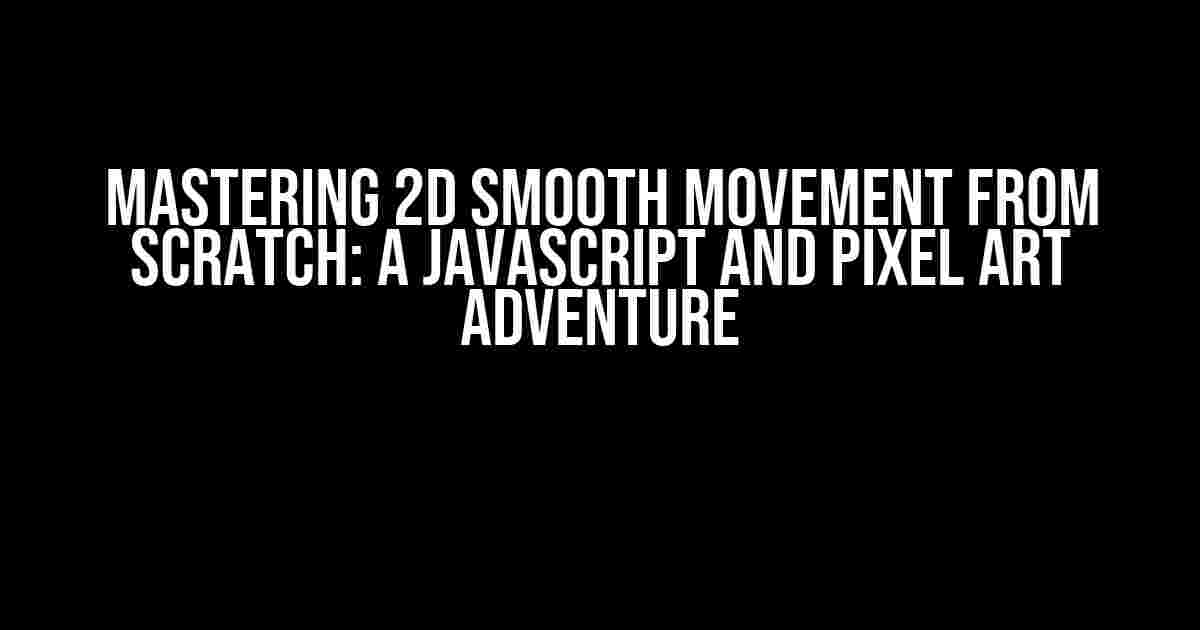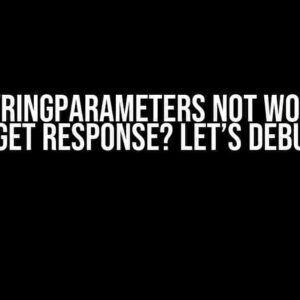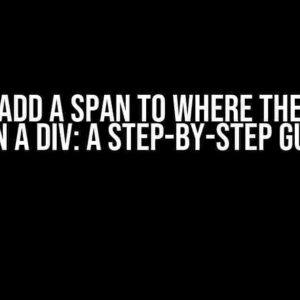Welcome, fellow game developers and pixel art enthusiasts! Are you tired of choppy, unresponsive movement in your 2D games? Do you want to create a seamless, silky-smooth experience that will leave your players begging for more? Look no further! In this epic tutorial, we’ll dive into the wonderful world of 2D smooth movement from scratch, using JavaScript and pixel art.
What is 2D Smooth Movement?
2D smooth movement refers to the ability of a game object to move fluidly and responsively across a 2D plane. This is achieved by manipulating the object’s position, velocity, and acceleration over time, using mathematical formulas and clever coding techniques. The result is a movement system that feels natural, intuitive, and downright magical.
Why Do We Need Smooth Movement?
Smooth movement is essential for creating an immersive gaming experience. It allows players to navigate the game world with ease, focus on the gameplay, and enjoy the thrill of exploration and discovery. Choppy or jerky movement, on the other hand, can be distracting, frustrating, and even nausea-inducing. By mastering 2D smooth movement, you’ll be able to craft games that are engaging, polished, and downright addictive.
Tools and Resources
For this tutorial, you’ll need the following tools and resources:
- A code editor or IDE (such as Visual Studio Code or Sublime Text)
- A JavaScript library or framework (such as Phaser or Pixi.js)
- A pixel art editor (such as Aseprite or Piskel)
- A willingness to learn and experiment!
Laying the Foundations: Understanding the Basics
Before we dive into the meat of the tutorial, let’s take a moment to review some fundamental concepts:
Coordinate Systems
In 2D space, we use the Cartesian coordinate system to define the position of objects. The x-axis represents horizontal movement, while the y-axis represents vertical movement.
x | y
---------
0 | 0 // origin point
1 | 0 // 1 pixel to the right
0 | 1 // 1 pixel up
-1 | 0 // 1 pixel to the left
0 | -1 // 1 pixel downVelocity and Acceleration
Velocity refers to the rate of change of an object’s position over time. Acceleration, on the other hand, is the rate of change of an object’s velocity over time. Think of it like this:
position = initial position + velocity * time
velocity = initial velocity + acceleration * timeCreating the Basic Movement System
Now that we have a solid understanding of the basics, let’s create a basic movement system using JavaScript and pixel art!
// define the game canvas and context
const canvas = document.getElementById('canvas');
const ctx = canvas.getContext('2d');
// define the player object
const player = {
x: 100,
y: 100,
vx: 0,
vy: 0
};
// define the update function
function update() {
// clear the canvas
ctx.clearRect(0, 0, canvas.width, canvas.height);
// update the player position
player.x += player.vx;
player.y += player.vy;
// draw the player
ctx.drawImage(playerSprite, player.x, player.y);
}
// define the handleInput function
function handleInput(event) {
switch (event.key) {
case 'ArrowUp':
player.vy = -5;
break;
case 'ArrowDown':
player.vy = 5;
break;
case 'ArrowLeft':
player.vx = -5;
break;
case 'ArrowRight':
player.vx = 5;
break;
}
}
// add event listeners
document.addEventListener('keydown', handleInput);
document.addEventListener('keyup', () => {
player.vx = 0;
player.vy = 0;
});
// start the game loop
setInterval(update, 16);Smoothing Out the Movement
The basic movement system is a great start, but we can do better! Let’s introduce some smoothing techniques to create a more fluid and responsive experience:
Linear Interpolation (Lerp)
Linear interpolation, or lerp, is a simple yet effective technique for smoothing out movement. It works by calculating the average of two values over time.
function lerp(start, end, amount) {
return start + (end - start) * amount;
}Acceleration and Deceleration
By introducing acceleration and deceleration, we can create a more natural and responsive movement system.
function update() {
// update the player velocity
player.vx += (targetX - player.x) * 0.1;
player.vy += (targetY - player.y) * 0.1;
// update the player position
player.x += player.vx;
player.y += player.vy;
}Tweening
Tweening is the process of smoothly interpolating between two values over time. We can use tweening to create smooth transitions between different movement states.
function tween(start, end, duration, ease) {
let time = 0;
let increment = 1 / duration;
return function() {
time += increment;
let value = ease(time);
return start + (end - start) * value;
}
}
// define the ease functions
function easeIn(time) {
return time * time;
}
function easeOut(time) {
return 1 - (1 - time) * (1 - time);
}
function easeInOut(time) {
if (time < 0.5) return easeIn(time * 2);
else return easeOut(time * 2 - 1);
}Adding Pixel Art and Visual Flair
Now that we have a solid movement system in place, let's add some pixel art flair to bring our game to life!
// define the player sprite
const playerSprite = new Image();
playerSprite.src = 'player.png';
// define the game background
const background = new Image();
background.src = 'background.png';
// draw the background and player
function draw() {
ctx.drawImage(background, 0, 0);
ctx.drawImage(playerSprite, player.x, player.y);
}
// call the draw function
setInterval(draw, 16);Conclusion
And there you have it, folks! With these techniques and tools, you're well on your way to creating silky-smooth 2D movement from scratch. Remember to experiment, iterate, and most importantly, have fun!
Bonus Materials
Want to take your 2D smooth movement skills to the next level? Check out these bonus materials:
- Pixi.js - a powerful JavaScript library for creating interactive, real-time graphics.
- Phaser - a popular open-source framework for creating HTML5 games.
- Aseprite - a fantastic pixel art editor for creating stunning graphics.
- Piskel - a free, web-based pixel art editor with a ton of features and resources.
Final Thoughts
Smooth movement is an essential component of any engaging 2D game. By mastering the techniques outlined in this tutorial, you'll be able to craft games that are not only visually stunning but also a joy to play. Happy coding, and see you in the next adventure!
Here are 5 Questions and Answers about "2D smooth movement from scratch (javascript, pixelart)" using a creative voice and tone:
Frequently Asked Question
Get ready to dive into the world of 2D smooth movement from scratch using JavaScript and pixel art!
What is the basics of 2D smooth movement in JavaScript?
The basics of 2D smooth movement in JavaScript involve using the HTML5 canvas element and JavaScript to create a game loop that updates the position of an object on the screen, typically using a velocity vector and acceleration to control the movement. It's all about creating a seamless and responsive experience for the player!
How do I create pixel art for my 2D game?
Creating pixel art for your 2D game involves using a graphics editor like Adobe Photoshop or Aseprite to design and create small, square pixels that make up your game's characters, enemies, and environments. You can also use online tools like Piskel or PixelArt.io to create pixel art directly in your browser!
What is the best way to handle collision detection in a 2D JavaScript game?
The best way to handle collision detection in a 2D JavaScript game is to use a combination of bounding box collision detection and pixel-perfect collision detection. Bounding box collision detection involves checking if two rectangles overlap, while pixel-perfect collision detection involves checking if individual pixels overlap. You can also use libraries like Phaser.io to simplify the process!
How do I add animation to my 2D game characters?
Adding animation to your 2D game characters involves creating a sprite sheet that contains multiple frames of the character in different poses, and then using JavaScript to cycle through the frames to create the illusion of movement. You can also use animation libraries like AnimeJS or GSAP to make the process easier!
What are some tips for creating smooth and responsive 2D movement in JavaScript?
Some tips for creating smooth and responsive 2D movement in JavaScript include using a consistent frame rate, using requestAnimationFrame to optimize performance, and implementing velocity-based movement to create a more realistic and responsive experience. You should also consider using interpolation to smooth out the movement and make it feel more fluid!
Let me know if you need anything else!





